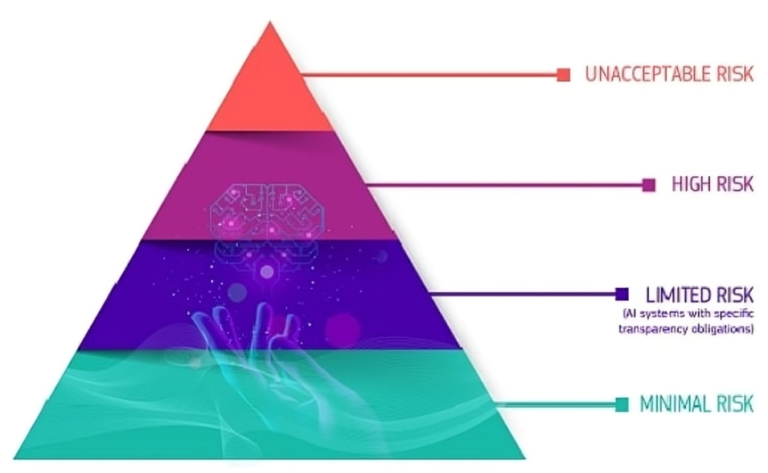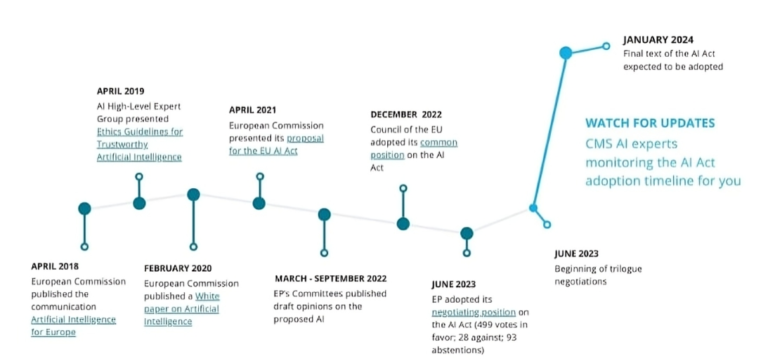
The European Union (EU) has taken a groundbreaking step with the introduction of the Artificial Intelligence Act. Passed on 9 December 2023, this regulation sets a global precedent by addressing the challenges and opportunities presented by AI. Let’s delve into the key aspects of this landmark legislation and its implications.
Understanding the Purpose of the EU AI Act
The primary goal of the European Union AI Act is to ensure the safety of AI systems in the EU market. And also providing legal certainty for investments and fostering innovation. By establishing a comprehensive framework, the regulation seeks to protect the rights and livelihoods of individuals. By applying to AI systems “placed on the market, put into service, or used in the EU.” This risk-based approach classifies AI systems into four categories: prohibited, high-risk, limited, and minimal risk.
The Main Provisions of the EU AI Act
Risk-Based Approach
The EU AI Act adopts a risk-based approach, categorizing AI systems based on their risk levels. Prohibited, high-risk, limited, and minimal-risk classifications guide the extent of oversight and regulation applied.
Scope and Exceptions
The regulation applies to developers, deployers, and global vendors involved with AI systems in the EU. Exceptions exist for AI systems only designed for military purposes.
Enforcement and Penalties
National competent market surveillance authorities will enforce the AI Act. It will impose fines for non-compliance ranging from €7.5 million or 1.5% of global turnover, depending on the infringement and company size.
Governance Structure and Innovation Support
The European AI Board (EAIB) established to guide and advise on AI regulation. Additionally, the proposal for a regulatory sandbox aims to support innovation in the AI sector.
The Four Categories of Risk Under the EU AI Act
Unacceptable Risk
Prohibited AI systems considered to pose an unacceptable risk to individuals’ safety, livelihoods, and rights.
High Risk
AI systems used in specific sectors, such as transport, education, employment, and welfare, likely to pose significant risks.
Limited Risk
AI systems not falling into the high or minimal risk categories
Minimal/None Risk
AI systems posing minimal or no risk, subject to the least oversight.

Timeline of the European Union AI Act
Passed on 9 December 2023, the AI Act is set to apply two years after its entry into force. Extensive negotiations, including trilogue meetings, led to a provisional agreement between the Council and the European Parliament. The Act’s provisions become applicable 24 months after its entry into force.

Human Supervision's Role in the EU AI Act
In simple terms, Article 14(1) of the EU AI Act says that for advanced AI systems that might be risky, people need to be in charge. This human oversight is crucial to avoid problems. It make sure that AI follows ethical rules, uses good-quality information, and is transparent in its actions. So, it’s like having a responsible adult watching over the AI to make sure it behaves well.
The AI Act's implementation involves several steps
Entry into Force: Two years after publication in the Official Journal of the European Union.
Application: Applicable to providers putting AI systems into service in the EU or placing them on the EU market.
Enforcement: Primarily through national competent market surveillance authorities, with fines for non-compliance.
Implementation Timeline: Expected to be fully implemented in early 2024.
Compliance: Developers, providers, and users must adhere to risk classifications, human oversight, and other specified provisions.
Current Status of EU AI Act Implementation
Currently, none of the countries have put the EU AI Act into action. The countries in the EU agreed on this regulation in December 2023. But it’s still waiting for the official approval from the EU Parliament and Council. Once they give the green light, it will take two more years before the rules kick in. And when they do, all EU member states will start following them at the same time. To sum it up, the European Union AI Act is like a big plan to make sure the safe and creative use of AI. It’s not in action but it will be a guide for all EU countries towards a responsible use of AI, protecting people’s rights and keeping things ethical. It’s a new way of doing things that could become an example for the whole world.
Good day! Do you know if they make any plugins to help with Search Engine Optimization? I’m trying to get my blog to rank for some targeted keywords
but I’m not seeing very good gains. If you know of
any please share. Thanks! You can read similar art here: Blankets